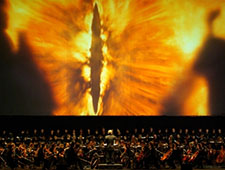
Vulture: Millennials Come Out for Howard Shore’s Thrilling Lord of the Rings in Concert
 By Justin Davidson
By Justin Davidson
Symphony orchestras run around in a perpetual Easter-egg hunt for young audiences, who always seem to vanish when they’re approached. Well, I’ve found them: This week they’re packing the Koch Theater for a live performance of a three-part contemporary video opera of Wagnerian proportions. Granted, Howard Shore’s score for The Lord of the Rings comes with a pre-excited public, and for the first time, all three of Peter Jackson’s megamovies are playing on consecutive nights on a big screen above a stage crammed with choristers and musicians. But this audience belongs to a generation that will watch action epics on their wristwatch, so it’s not just the scale of the image that pulls them in.
No, it’s the sheer, thrilling might of a live and very large orchestra and chorus, with double basses and percussion making the floorboards tremble and a first-class brass section ringing in Armageddon. On the night I attended The Two Towers, the crowd was listening hard — you could tell because it didn’t wait for pauses but broke into spontaneous applause for the concertmaster’s fiddle tune and whooped at a superior bassoon solo. When was the last time that happened at the New York Philharmonic?
The event is no mere sop to Tolkien nerds. The Swiss conductor Ludwig Wicki created the 21st Century Symphony Orchestra and Chorus to take this sort of symphonic spectacle on tour, and there’s no stinting on quality. The Brooklyn Youth Chorus sings with unflinching energy and polish in a variety of languages — including, of course, Elvish and Sindarin. Soprano Kaitlyn Lusk has a voice so pure and plaintive that at one point I mistook it for a Theremin.
Placing the score before the screen makes it clear how expertly Shore carried out a daunting musical mission. Film composers once used their scores to juice a multitude of ordinary shots — they had to transform a carpeted hallway into a terrifying trap or turn an alarmed glance into a psychotic stare. But Shore added musical intensity to some of the highest-octane, most obsessive filmmaking of all time. It takes chops to write a march menacing enough to enhance the view of 10,000 digitized monsters marching through the plains. Leaving hardly a tune-free moment, he invented a quasi-Norse folk music for the kingdom of Rohan, accompanied Gollum’s guttural complaints with a tremulous dulcimer, deployed some aleatoric string washes that would have done the modernist master Witold Lutoslawski proud, and wrote for brass choir with Straussian flare. And whenever you think you’ve reached the most bone-shaking climax an orchestra could possibly release, there’s another louder, tenser one waiting just over the next Alpine ridge. This is music that Bruckner would have written if he’d lived in California and had to lock his crescendos to the length of a battle instead of being a pious Austrian organist with nothing but time on his hands.
So if all these members of a supposedly gizmo-addicted generation with truncated attention spans and little demonstrable interest in classical music are sitting happily through a ten-hour orchestral marathon, should the classical music world be pleased? No, because these young people come for a special event, not loyalty to an artistic genre. But also yes, because they come away having had an experience that makes the music of the past seem less like a foreign country, and because it reaffirms what every concert-hall habitué already knows: There’s no acoustic power in the world like the sound of a big orchestra going for broke.
From April 10, 2015, this article appears at: http://www.vulture.com/2015/04/millennials-come-out-for-lotr-in-concert.html.
You may also like
Follow on:
facebook
Upcoming Concerts:

The Two Towers
Live to Projection
Quebec, Canada
Sept 5 - 6, 2025
Montreal, Canada
Jan 9 - 11, 2026

The Return of the King
Live to Projection
Antwerp, Belgium
Sept 18 - 21, 2025
Rotterdam, Netherlands
Dec 18 - 21, 2025
Munich, Germany
March 14, 2026
